Kowloon
- "Kowloon" is a transliteration of 九龍. For other transliterations, see 九龍 (disambiguation).
| Kowloon | |
|---|---|
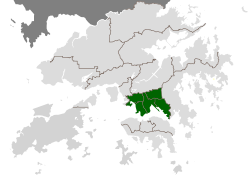 |
|
| Population (2006) | |
| - Total | 2,019,533 |
| - Density | 43,033/km2 (111,455/sq mi) |
| Time zone | Hong Kong Time (UTC+8) |
| Kowloon | |||||||||||||||||||
|---|---|---|---|---|---|---|---|---|---|---|---|---|---|---|---|---|---|---|---|
| Traditional Chinese | 九龍 | ||||||||||||||||||
| Simplified Chinese | 九龙 | ||||||||||||||||||
| Literal meaning | Nine dragons | ||||||||||||||||||
|
|||||||||||||||||||
Kowloon (English pronunciation: /ˌkaʊˈluːn/) is an urban area in Hong Kong, comprising the Kowloon Peninsula and New Kowloon. It is bordered by the Lei Yue Mun strait in the east, Mei Foo Sun Chuen and Stonecutter's Island in the west, Tate's Cairn and Lion Rock in the north, and Victoria Harbour in the south. It had a population of 2,019,533 and a population density of 43,033/km2 in 2006. Kowloon is located north of Hong Kong Island and south of the mainland part of the New Territories. The peninsula's area is approximately 47 km2 or 18.1 mi2. Together with Hong Kong Island, it contains 48% of Hong Kong's total population.
The systematic transcription Kau Lung or Kau-lung was often used in derived place names before World War II, for example Kau-lung Bay instead of Kowloon Bay. Other spellings include Kauloong.
Contents |
History
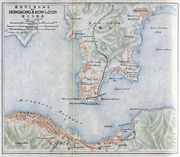
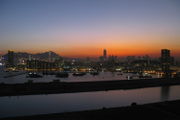
The name Kowloon came from the nine dragons represented by eight peaks and a Chinese emperor: Kowloon Peak, Tung Shan, Tate's Cairn, Temple Hill, Unicorn Ridge, Lion Rock, Beacon Hill, Crow's Nest and Emperor Bing.[1]
The part of Kowloon south of Boundary Street, together with Stonecutters Island, was ceded by Qing China to the United Kingdom under the Convention of Peking of 1860. For many years the area remained largely undeveloped, used by the British mainly for tiger-hunting expeditions.
The part of Kowloon north of Boundary Street (New Kowloon) was leased by the British as part of the New Territories in 1898 for 99 years. Within New Kowloon is the Kowloon City, which refers to an area, where the Kowloon Walled City used to be located. The Kowloon Walled City itself was demolished in 1993. The same area was called 官富場 (Pinyin: Guanfuchang) during the Song Dynasty.
Statutorily, "Kowloon" has remained to refer to the area south of Boundary Street and the Stonecutters Island. "New Kowloon" has also remained part of the New Territories.
In modern day conversations, however, New Kowloon is often not regarded as part of the New Territories, but as an integral part of the Kowloon urban area on both sides of Boundary Street. For rates tax purposes, New Kowloon is not considered part of Kowloon and remains part of the New Territories as according to the statutes. Properties in New Kowloon are subjected to pay the land leases as those in the New Territories.
Large-scale development of Kowloon began in the early 20th century, with the construction of the Kowloon-Canton Railway and the Kowloon Wharf.
Due to Kowloon's close proximity to Kai Tak Airport, building constructions were limited by flight paths. Compared to Hong Kong Island, Kowloon resulted architecturally in much lower skyline.[1] After World War II Kowloon became extremely congested when slums for refugees from the newly established People's Republic of China gave way to public housing estates, mixed with private residential, commercial and industrial areas.
West Kowloon was once home to a dockyard for the Royal Navy and is now used as a typhoon shelter. It is usually reached by boat; namely the Star Ferry. On 1 July 1997, both parts of Kowloon were transferred to the People's Republic of China along with the rest of Hong Kong.
Administration
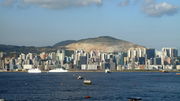
It comprises the following districts:
- Kowloon City
- Kwun Tong
- Sham Shui Po
- Wong Tai Sin
- Yau Tsim Mong
Politics
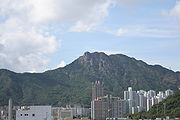
Kowloon covers two geographical constituencies for the Legislative Council of Hong Kong:
- Kowloon East includes Wong Tai Sin and Kwun Tong.
- Kowloon West includes Yau Tsim Mong, Sham Shui Po and Kowloon City.
City landscape

See also
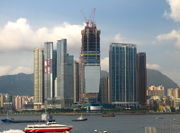
- Argyle Street
- List of mountains, peaks and hills in Hong Kong
- Nathan Road
- West Kowloon Cultural District
References
External links
 Media related to Kowloon and Kowloon West at Wikimedia Commons
Media related to Kowloon and Kowloon West at Wikimedia Commons- The West Kowloon Cultural Village website - New Project!
- Cap 1 Sched 4 Area of Kowloon
|
|||||||||||||||||||
